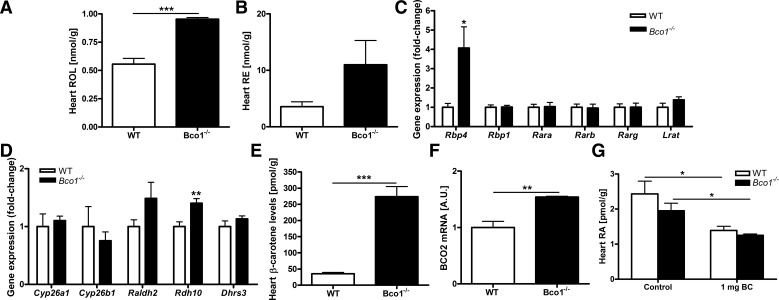Fig. 5.
Heart retinoid and β-carotene levels as well as expression levels for genes associated with retinoid physiology. Heart levels of retinol (ROL; A) and β-carotene (E) were significantly elevated in Bco1−/− mice compared with WT mice. Although heart retinyl ester (RE) levels tended to be higher for Bco1−/− mice, this did not reach statistical significance (B). Of the genes encoding enzymes and binding proteins involved in retinoid metabolism, only retinol-binding protein 4 (Rbp4) (C) and retinol dehydrogenase 10 (Rdh10; D) were expressed at significantly different levels in hearts of WT and Bco1−/− mice. Heart levels of all-trans-retinoic acid (RA) were not significantly different for Bco1−/− versus WT mice fed a chow diet (G). For both Bco1−/− and WT mice, heart all-trans-retinoic acid levels were significantly diminished upon administration of a single dose of β-carotene (1 mg) given 3 days before euthanization. Gene expression data established that only levels for Rbp4 mRNA (E) and β-carotene-9′,10′-oxygenase 2 (Bco2) mRNA (F) were significantly different for Bco1−/− mice versus matched WT mice. Rara, Rarb, and Rarg, retinoic acid receptor-α, -β, and -γ, respectively; Lrat, lecithin retinol acyltransferase; Cyp, cytochrome P-450; Raldh2, aldehyde dehydrogenase 1 family member A2; Dhrs3, dehydrogenase/reductase (SDR family) member 3. Values are means ± SE; n = 5–8. *P < 0.05; **P < 0.01; ***P < 0.001.

